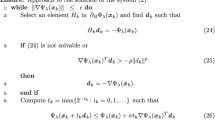Abstract
In this paper, the nonlinear complementarity problem is transformed into the least squares problem with nonnegative constraints, and a SQP algorithm for this reformulation based on a damped Gauss-Newton type method is presented. It is shown that the algorithm is globally and locally superlinearly (quadratically) convergent without the assumption of monotonicity.
Similar content being viewed by others
References
Nesterov, Y. and Nemirovskii, A., Interior Point Polynomial Algorithm in Convex Programming, SIAM Publications, Philadelphia, PA, USA, 1994.
Xiu, N. and Gao, Z., The new advances in methods for complementarity problems, Advances in Mathematics, 1999, 28(3):193–210.
Ye, Y., Interior Point Algorithm: Theory and Analysis, John Wiley and Sons, Inc., New York, 1997.
Monteiro, R. D. C., Pang, J. S. and Wang, T., a positive algorithm for the nonlinear complementarity problem, SIAM J. Optim., 1995, 5:129–148.
Moré, J. J., Global methods for nonlinear complementarity problems, Math. Oper. Res., 1996, 21:589–614.
Pang, J. S. and Gabriel, S. A., NE/SQP: a robust algorithm for the nonlinear complementarity problem, Math. Programming, 1993, 60:295–338.
Pang, J. S. and Qi, L., A globally convergent Newton method for convex SC1 minimization problems, JOTA, 1995, 85(3):633–648.
Wang, T., Monteiro, R. D. C. and Pang, J. S., An interior point potential reduction method for constrained equations, Math. Programming, 1996, 74:159–195.
Subramanian, P. K., Gauss-Newton methods for the complementarity problem, JOTA, 1993, 77(3):467–482.
Subramanian, P. K. and Xiu, N. H., Convergence analysis of Gauss-Newton methods for the complementarity problem, JOTA, 1997, 94:727–738.
Chen, B. and Harker, P. T., Smoothing approximations to nonlinear complementarity problems, SIAM J. Optim., 1997, 7:403–420.
Cottle, R. W., Pang, J. S. and Stone, R. E., The Linear Complementarity Problem, Academic Press, Boston, 1992.
Fischer, A., A Newton-type method for positive semi-definite linear complementarity problems, JOTA, 1995, 86:585–608.
Kanzow, C., Global convergence properties of some iterative methods for linear complementarity problems, SIAM J. Optim., 1996, 6:326–341.
Author information
Authors and Affiliations
Additional information
Supported by the National Natural Science Foundation of China (19971002).
Rights and permissions
About this article
Cite this article
Naihua, x. A SQP method for general nonlinear complementarity problems. Appl. Math. Chin. Univ. 15, 433–442 (2000). https://doi.org/10.1007/s11766-000-0041-4
Received:
Issue Date:
DOI: https://doi.org/10.1007/s11766-000-0041-4



